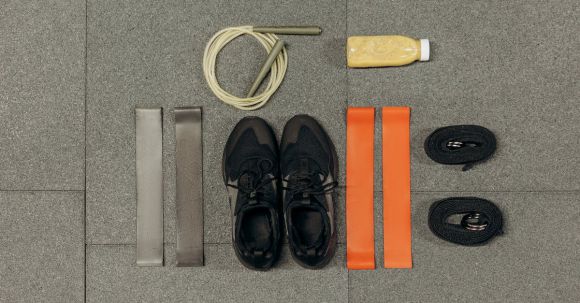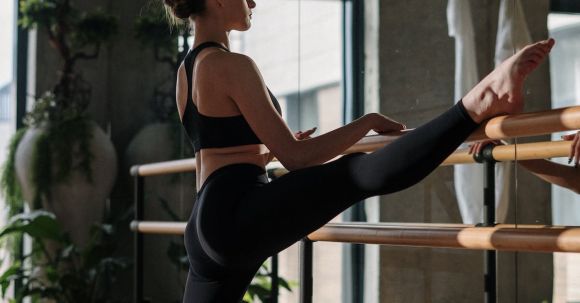Pilates is a low-impact form of exercise that focuses on strengthening the core, improving flexibility, and enhancing overall body strength. It was developed by Joseph Pilates in the early 20th century and has gained popularity worldwide due to its numerous benefits. Whether you are a fitness enthusiast or a beginner, incorporating Pilates into your fitness routine can bring about significant positive changes in your health and well-being.
Author: fit-on
Are you tired of struggling with your weight? Do you feel like you've tried every diet and exercise program out there, only to see minimal results? If so, it's time to try something different. Fit on Weight Loss Programs is here to help you get fit and stay fit, all while enjoying the journey.
Why Choose Fit on Weight Loss Programs?
When it comes to weight loss, there is no one-size-fits-all solution. That's why Fit on Weight Loss Programs offers a variety of options to suit your individual needs and goals. Whether you prefer a structured meal plan, personalized workouts, or weekly coaching sessions, Fit on Weight Loss Programs has something for everyone.1. Personalized Meal Plans
One of the keys to successful weight loss is a healthy diet. Fit on Weight Loss Programs understands this and provides personalized meal plans tailored to your specific needs. Say goodbye to restrictive diets and hello to delicious, nutritious meals that will keep you satisfied and on track to reaching your goals.2. Effective Workouts
Exercise is an essential component of any weight loss journey. Fit on Weight Loss Programs offers a wide range of workouts designed to burn fat, build muscle, and improve your overall fitness level. From cardio and strength training to yoga and Pilates, there's a workout for every preference and ability.3. Weekly Coaching Sessions
Sometimes, we all need a little extra support and motivation to stay on track. That's where Fit on Weight Loss Programs' weekly coaching sessions come in. These sessions provide you with the guidance and accountability you need to stay focused and make progress towards your goals. Your coach will be there every step of the way to celebrate your successes and help you overcome any obstacles that may come your way.The Benefits of Getting Fit and Staying Fit
Getting fit and staying fit offers numerous benefits beyond just weight loss. Here are some of the ways that prioritizing your health and fitness can improve your life:1. Increased Energy Levels
Regular exercise and a healthy diet can do wonders for your energy levels. By fueling your body with nutritious foods and engaging in physical activity, you'll find yourself feeling more energized and ready to take on the day.2. Improved Mental Clarity
Exercise has been shown to improve cognitive function and enhance mental clarity. When you prioritize your fitness, you'll find that you can think more clearly, focus better, and even reduce stress levels.3. Boosted Confidence
There's nothing quite like the feeling of accomplishment that comes from achieving your fitness goals. As you get fit and stay fit, you'll notice improvements in your physical appearance, strength, and overall health. This newfound confidence will radiate into all areas of your life, helping you to feel more confident and capable in everything you do.In Conclusion
If you're ready to take control of your health and transform your life, Fit on Weight Loss Programs is here to help. With personalized meal plans, effective workouts, and weekly coaching sessions, you'll be well-equipped to get fit and stay fit for the long haul. Say goodbye to fad diets and hello to a sustainable, enjoyable weight loss journey. Start your transformation today and see the incredible results that are possible when you prioritize your health and well-being.
When it comes to improving your performance in any sport, it is crucial to train efficiently and effectively. One of the most effective ways to do this is through sports-specific training. By tailoring your training regimen to mimic the demands of your sport, you can optimize your performance and minimize the risk of injury. In this article, we will explore the importance of sports-specific training and provide you with some tips on how to incorporate it into your routine.
Understanding the Importance of Sports-specific Training
Sports-specific training involves exercises and drills that closely mimic the movements and skills required in a particular sport. This type of training helps to improve your strength, speed, agility, and endurance in a way that directly translates to your performance on the field, court, or track. By focusing on the specific demands of your sport, you can target the muscles and energy systems that are most important for success.Tailoring Your Training to Your Sport
To effectively train for your sport, it is essential to identify the key skills and physical attributes required. For example, if you are a basketball player, your training should include exercises that improve your jumping ability, agility, and shooting skills. On the other hand, if you are a long-distance runner, your training should focus on building endurance and improving your running technique.Incorporating Sports-specific Exercises
Once you have identified the key skills and physical attributes needed for your sport, you can incorporate sports-specific exercises into your training routine. These exercises should closely mimic the movements and demands of your sport. For example, if you are a tennis player, you could include drills that involve rapid changes of direction, quick footwork, and explosive shots. By simulating the movements and intensity of your sport, you can improve your performance and reduce the risk of injury.Developing Strength and Power
Strength and power are crucial for success in many sports. To develop these attributes, you can incorporate exercises such as squats, deadlifts, and plyometric exercises into your training routine. These exercises help to build muscular strength and power, which can enhance your performance in sports that require explosive movements, such as sprinting, jumping, and throwing.Improving Speed and Agility
Speed and agility are essential for athletes in sports such as soccer, basketball, and tennis. To improve your speed, you can include exercises such as sprints, shuttle runs, and ladder drills in your training routine. These exercises help to improve your acceleration, top speed, and change of direction abilities. By incorporating speed and agility training into your routine, you can gain a competitive edge on the field or court.Enhancing Endurance
Endurance is critical for athletes participating in endurance sports such as long-distance running, cycling, and swimming. To enhance your endurance, you can incorporate activities such as long runs, cycling intervals, and swimming drills into your training routine. These exercises help to improve your aerobic capacity and muscular endurance, allowing you to sustain high-intensity efforts for longer periods.Conclusion: Unlock Your Full Potential
In conclusion, sports-specific training is essential for athletes looking to improve their performance and reach their full potential. By tailoring your training routine to mimic the demands of your sport, you can optimize your strength, speed, agility, and endurance. Remember to identify the key skills and physical attributes required for your sport and incorporate sports-specific exercises into your routine. By doing so, you will be well on your way to becoming a more efficient and successful athlete.
Setting fitness goals is a crucial step towards achieving a healthier lifestyle. However, many people struggle to set goals that are both realistic and achievable. In this article, we will explore some key strategies for setting fitness goals that will help you stay motivated and on track.
Assess Your Current Fitness Level
Before setting any fitness goals, it's important to assess your current fitness level. This will give you a baseline from which to track your progress. Consider factors such as your cardiovascular endurance, strength, flexibility, and body composition. You can also consult with a fitness professional who can help you determine your starting point.Define Your Why
Understanding your motivation for wanting to achieve your fitness goals is crucial. Take some time to reflect on why you want to make changes in your life. Do you want to improve your overall health? Are you training for a specific event or sport? By defining your why, you will be more likely to stay committed when challenges arise.Set Specific and Measurable Goals
Setting specific and measurable goals is essential for tracking your progress. Instead of saying, "I want to lose weight," try setting a goal such as, "I want to lose 10 pounds in the next three months." This gives you a clear target to work towards and allows you to measure your success along the way.Break It Down
Once you have set your main goal, break it down into smaller, more manageable steps. This will make your goals feel less overwhelming and more achievable. For example, if your goal is to run a marathon, start by setting smaller goals such as running a 5K or a half marathon. Each milestone reached will boost your confidence and keep you motivated.Be Realistic
When setting fitness goals, it's important to be realistic. Consider your current lifestyle, commitments, and limitations. Setting goals that are too ambitious or unrealistic can lead to frustration and disappointment. It's better to set smaller, attainable goals that you can build upon over time.Create a Plan
Once you have defined your goals, create a plan of action. Break down your goals into monthly, weekly, and daily tasks. This will help you stay organized and focused on the steps needed to achieve your goals. For example, if your goal is to improve your strength, your plan might include three strength training sessions per week and gradually increasing the weight or intensity over time.Track Your Progress
Tracking your progress is crucial for staying motivated and accountable. Keep a journal or use an app to record your workouts, measurements, and any other relevant data. This will allow you to see how far you've come and identify areas where you may need to adjust your approach.Stay Flexible
While it's important to set specific goals, it's equally important to stay flexible. Life happens, and there may be times when you need to adjust your goals or approach. Be open to making changes as needed, and remember that progress is not always linear. As long as you're consistently working towards your goals, you will continue to move forward.Celebrate Your Achievements
Finally, don't forget to celebrate your achievements along the way. Take time to acknowledge your progress and reward yourself for reaching milestones. This will help you stay motivated and reinforce the positive habits you've developed. In conclusion, setting realistic and achievable fitness goals is essential for long-term success. By assessing your current fitness level, defining your why, setting specific and measurable goals, breaking them down, and creating a plan, you will be well on your way to achieving your desired results. Remember to track your progress, stay flexible, and celebrate your achievements. With dedication and perseverance, you can transform your health and fitness one goal at a time.
In today's fast-paced world, stress and tension seem to be an inevitable part of our lives. From the demands of work to personal responsibilities, it can be challenging to find moments of peace and relaxation. However, one effective way to release tension and find inner calm is through yoga stretches. By incorporating these stretches into your daily routine, you can not only improve your physical well-being but also achieve a sense of peace and tranquility.
Relax the Mind, Relax the Body
Yoga stretches are not just about physical flexibility; they also offer a mental release. As you move through each pose, focusing on your breath and being present in the moment, you allow your mind to let go of worries and stress. This mental relaxation has a profound effect on your physical body, helping to release tension and tightness.Child's Pose: Embrace Comfort and Surrender
One of the most soothing yoga stretches is the Child's Pose. This pose allows you to curl up into a fetal position, symbolizing a return to a place of comfort and safety. As you sink into this pose, focus on your breath and let go of any tension in your body. Feel the gentle stretch in your lower back and shoulders, and allow yourself to surrender to the pose. Stay in this position for a few deep breaths, feeling the tension melt away.Downward-Facing Dog: Energize and Lengthen
The Downward-Facing Dog is a foundational yoga pose that stretches and strengthens the entire body. This pose helps to release tension in the shoulders and hamstrings while lengthening the spine. As you raise your hips towards the ceiling and press your heels towards the ground, feel the energizing stretch in your entire body. Take deep breaths in this pose, allowing the tension to release with each exhale.Warrior II: Find Strength in Stillness
The Warrior II pose is a powerful posture that not only strengthens the legs and core but also cultivates a sense of inner strength and stability. As you step your feet wide apart and turn your front foot forward, feel the strength and grounding in your legs. Extend your arms out to the sides, reaching through your fingertips, and find stillness in this pose. Embrace the sense of power and peace that comes with holding the Warrior II pose.Corpse Pose: Surrender and Let Go
The final pose in any yoga practice is Corpse Pose, also known as Savasana. This pose is a time for complete surrender and relaxation. Lie on your back with your arms and legs extended, palms facing up. Close your eyes and allow your body to sink into the ground. Focus on your breath and let go of any lingering tension or thoughts. Stay in this pose for a few minutes, enjoying the peace and stillness that it brings.Incorporating Yoga Stretches into your Routine
To experience the full benefits of yoga stretches, it is essential to incorporate them into your daily routine. Set aside a specific time each day, whether it is in the morning or evening, to dedicate to your yoga practice. Start with just a few poses and gradually increase the duration and complexity of your practice. Remember to listen to your body and not push yourself beyond your limits. With consistency and patience, you will begin to notice the release of tension and the emergence of inner peace. In conclusion, yoga stretches offer a powerful tool for releasing tension and finding peace in our hectic lives. Through these poses, we can relax the mind, relax the body, and cultivate a sense of inner calm. By incorporating these stretches into our daily routine and dedicating time to our yoga practice, we can experience the transformative benefits that yoga has to offer. So, roll out your mat, take a deep breath, and begin your journey towards release and peace through yoga stretches.
Staying fit and healthy is a priority for many individuals, and one great way to achieve this is through regular exercise. While going to the gym or attending fitness classes may not always be feasible, you can still get an effective full body workout right in the comfort of your own home. In this article, we will explore some simple yet effective exercises that target all major muscle groups, allowing you to achieve a full body workout without any fancy equipment.
Warm-Up: Prepare Your Body for Action
Before diving into the workout routine, it is crucial to warm up your body and get your muscles ready for action. A proper warm-up helps to increase blood flow, improve flexibility, and reduce the risk of injury. Spend 5-10 minutes engaging in dynamic stretches such as arm circles, leg swings, and torso twists. This will help to activate your muscles and prepare them for the workout ahead.1. Push-Ups: Strengthen Your Upper Body
Push-ups are a classic exercise that primarily targets the chest, shoulders, and triceps. To perform a push-up, start in a high plank position with your hands slightly wider than shoulder-width apart. Lower your body by bending your elbows until your chest grazes the floor, then push back up to the starting position. Aim for 3 sets of 10-15 reps, or as many as you can comfortably do.2. Squats: Work Those Leg Muscles
Squats are a fantastic exercise for targeting the lower body, particularly the quadriceps, hamstrings, and glutes. Begin by standing with your feet shoulder-width apart. Lower your body as if you were sitting back into an imaginary chair, keeping your chest lifted and your knees tracking over your toes. Push through your heels to return to the starting position. Aim for 3 sets of 12-15 reps.3. Plank: Engage Your Core
The plank is an excellent exercise for strengthening your core muscles, including the abs, back, and hips. Start by lying face down on the floor, then lift your body onto your forearms and toes, keeping your elbows directly under your shoulders. Engage your core and hold this position for as long as you can, aiming for at least 30 seconds to begin with. Repeat for 3 sets.4. Lunges: Tone Your Legs and Glutes
Lunges are another effective exercise for working your lower body, specifically the quadriceps, hamstrings, and glutes. Stand with your feet hip-width apart, then take a big step forward with your right foot. Lower your body until your right knee is bent at a 90-degree angle, with your left knee hovering just above the ground. Push through your right heel to return to the starting position, then repeat on the other side. Aim for 3 sets of 10-12 reps on each leg.5. Burpees: Get Your Heart Pumping
Burpees are a full body exercise that combines strength training and cardiovascular conditioning. Begin by standing with your feet shoulder-width apart. Lower your body into a squat position, then place your hands on the floor in front of you and kick your feet back into a high plank position. Jump your feet back towards your hands and explosively jump up into the air, reaching your arms overhead. Repeat for 3 sets of 8-10 reps. Incorporating these exercises into your regular workout routine can help you achieve a full body workout without ever leaving home. Remember to start slow and gradually increase the intensity and duration of your workouts as your fitness levels improve. Stay consistent, and you'll be on your way to a stronger, fitter, and healthier you in no time!
Winter can often be a challenging time to stay active. The cold weather, shorter days, and holiday festivities can make it tempting to curl up on the couch and hibernate until spring. However, staying active during the winter months is crucial for maintaining both physical and mental well-being. Here are some tips to help you stay active and beat the winter blues.
Find Indoor Activities
One of the easiest ways to stay active during the winter is to find indoor activities that you enjoy. Joining a gym or fitness center can provide you with a wide range of options, from cardio machines and weightlifting to group fitness classes. If the gym isn't your thing, consider indoor sports such as basketball, racquetball, or swimming. You could also try out yoga or Pilates classes for a low-impact workout that focuses on strength and flexibility.Bundle Up and Head Outside
While it may be tempting to stay indoors when the temperatures drop, getting outside for some fresh air and exercise can do wonders for your physical and mental health. Bundle up in warm layers, including a hat, gloves, and a scarf, and head out for a brisk walk or jog. If you enjoy winter sports, try skiing, snowboarding, or ice skating. These activities not only provide a great workout but also allow you to enjoy the beauty of the winter season.Set Goals and Create a Schedule
Setting goals and creating a schedule can help you stay motivated and accountable during the winter months. Whether your goal is to exercise a certain number of times per week or to complete a specific workout routine, having something to work towards can keep you on track. Break your goals into smaller, manageable tasks and schedule them into your weekly routine. Having a plan in place will make it easier to stick to your fitness regimen, even when the weather isn't cooperating.Try New Activities
Winter is a great time to try new activities that you may not have considered before. Take advantage of the season by trying activities such as snowshoeing, cross-country skiing, or winter hiking. These activities not only provide a great workout but also allow you to explore the great outdoors in a whole new way. If you prefer indoor activities, consider trying out a new fitness class or workout routine. Trying something new can help prevent boredom and keep you motivated to stay active.Stay Hydrated and Eat Well
Staying active during the winter months also means taking care of your body by staying hydrated and eating well. It can be easy to neglect these aspects of your health during the holiday season, but it's important to remember that proper nutrition and hydration are essential for energy and recovery. Drink plenty of water throughout the day and make sure to eat a balanced diet that includes plenty of fruits, vegetables, lean proteins, and whole grains. In conclusion, staying active during the winter months is essential for maintaining your health and well-being. By finding indoor activities, bundling up and heading outside, setting goals and creating a schedule, trying new activities, and taking care of your body through proper hydration and nutrition, you can stay active and beat the winter blues. So, don't let the winter weather hold you back; embrace the season and stay active all year round.
Yoga has long been recognized for its countless benefits to both the body and mind. From increased flexibility and strength to reduced stress and anxiety, the practice of yoga provides a holistic approach to overall health and well-being. One area where yoga truly shines is in its ability to improve cardiovascular health. By incorporating dynamic yoga sequences into your regular practice, you can effectively boost your heart health and enhance your overall fitness level.
Understanding Cardiovascular Health
Before delving into the specific benefits of dynamic yoga sequences, it's important to understand what cardiovascular health entails. The cardiovascular system is responsible for circulating blood throughout the body, delivering oxygen and nutrients to the organs and tissues. A healthy cardiovascular system ensures that the body functions optimally, reducing the risk of heart disease, stroke, and other cardiovascular conditions. Regular exercise, such as dynamic yoga, plays a crucial role in maintaining and improving cardiovascular health.Dynamic Yoga Sequences: A Cardiovascular Workout
Unlike traditional static yoga poses, dynamic yoga sequences involve continuous movement, flowing from one pose to another in a fluid manner. These sequences are designed to increase heart rate, improve blood circulation, and challenge the cardiovascular system. By incorporating vigorous movements and transitions, dynamic yoga sequences provide a cardiovascular workout that can be as effective as other forms of aerobic exercise.Engaging the Heart and Lungs
Dynamic yoga sequences engage both the heart and lungs, strengthening these vital organs and improving their efficiency. As the body moves through various poses and transitions, the heart rate increases, forcing the heart to work harder. This increased workload strengthens the heart muscle, improving its ability to pump blood efficiently. Additionally, the deep and controlled breathing techniques used in yoga help to expand lung capacity, enhancing oxygen uptake and improving overall cardiovascular function.Boosting Endurance and Stamina
Regular practice of dynamic yoga sequences can significantly improve endurance and stamina. By challenging the cardiovascular system, these sequences increase the body's ability to sustain physical activity for longer periods of time. This improved endurance not only benefits cardiovascular health but also enhances overall fitness levels, allowing individuals to engage in other forms of physical activity with greater ease and efficiency.Reducing Blood Pressure and Cholesterol Levels
High blood pressure and elevated cholesterol levels are major risk factors for cardiovascular disease. Dynamic yoga sequences have been shown to effectively reduce both blood pressure and cholesterol levels, thereby reducing the risk of developing heart disease. The combination of aerobic exercise, stress reduction, and improved blood circulation provided by yoga helps to lower blood pressure and promote healthy cholesterol levels, further enhancing cardiovascular health.Enhancing Stress Management
Stress is a significant contributor to cardiovascular disease. The practice of dynamic yoga sequences promotes stress reduction and relaxation, benefiting cardiovascular health in multiple ways. By engaging in a rhythmic and flowing practice, individuals can release tension, reduce anxiety, and lower stress levels. This, in turn, helps to regulate blood pressure, improve heart rate variability, and promote overall cardiovascular well-being.Incorporating Dynamic Yoga Sequences into Your Practice
To reap the cardiovascular benefits of dynamic yoga sequences, it's important to incorporate them into your regular yoga practice. Start by selecting a sequence that suits your fitness level and gradually increase the intensity as you progress. Remember to listen to your body and modify poses as needed. Consistency is key, so aim to practice dynamic yoga sequences at least two to three times per week to experience the full benefits. Conclusion: Dynamic yoga sequences provide a powerful and effective means of improving cardiovascular health. By engaging the heart and lungs, boosting endurance and stamina, reducing blood pressure and cholesterol levels, and enhancing stress management, these sequences offer a comprehensive approach to cardiovascular fitness. Incorporate dynamic yoga into your regular practice and take a proactive step towards a healthier heart and a healthier you.
When it comes to sports and physical activities, speed and agility are two crucial factors that can make a significant difference in performance. Whether you're a professional athlete or someone who enjoys staying active, improving your speed and agility can enhance your overall fitness level and help you excel in your chosen activities. In this article, we will explore some effective strategies to boost your speed and agility.
Proper Warm-Up and Cool-Down
Before diving into any physical activity, it is essential to warm up your body properly. A dynamic warm-up routine that includes exercises like jogging, high knees, and lunges will help prepare your muscles and joints for the upcoming workout. It increases blood flow, raises your body temperature, and loosens up your muscles, reducing the risk of injuries. Similarly, cooling down after a workout is just as important. It allows your heart rate and body temperature to gradually return to normal and prevents muscle soreness. Incorporate static stretches and gentle movements to help your body recover effectively.Interval Training
Interval training is a highly effective method to improve your speed and agility. This training technique involves alternating between high-intensity bursts of exercise and short recovery periods. For example, you can sprint for 30 seconds and then walk or jog for 1 minute. Repeat this cycle for a set duration, gradually increasing the intensity and duration over time. Interval training not only develops your cardiovascular endurance but also enhances your speed and agility by challenging your body to adapt to different intensities and speeds. It simulates the demands of sports and activities that require quick bursts of energy, making it a valuable training tool.Plyometric Exercises
Plyometric exercises are explosive movements that involve a rapid stretch and contraction of muscles. They improve power, speed, and agility by increasing the efficiency of your muscle contractions. Examples of plyometric exercises include squat jumps, box jumps, and lateral bounds. When performing plyometric exercises, focus on generating as much force as possible during the explosive phase of the movement. Land softly to absorb the impact and immediately transition into the next repetition. Start with basic exercises and gradually progress to more challenging variations as your strength and coordination improve.Agility Drills
Agility drills are designed to improve your ability to change direction quickly and efficiently. They enhance your reaction time, coordination, and balance. Cone drills, ladder drills, and shuttle runs are popular agility exercises that can be easily performed on any flat surface. To maximize the benefits, perform agility drills with precision and focus on proper technique. Stay light on your feet, maintain a low center of gravity, and use quick, controlled movements. Challenge yourself by increasing the speed or complexity of the drills as you improve.Flexibility Training
Flexibility plays a crucial role in speed and agility. It allows your muscles to move through their full range of motion, which improves your stride length, reduces the risk of injuries, and enhances overall performance. Incorporate regular stretching exercises into your training routine to increase flexibility. Focus on both static and dynamic stretches. Static stretches involve holding a position for a prolonged period, while dynamic stretches involve continuous movement. Stretch major muscle groups such as hamstrings, quadriceps, calves, and hip flexors to maintain optimal flexibility. In conclusion, improving your speed and agility requires a combination of various training methods and techniques. Incorporate proper warm-up and cool-down routines, interval training, plyometric exercises, agility drills, and flexibility training into your workouts. Consistency and dedication are key, so make sure to stay committed to your training regimen. With time and effort, you will notice significant improvements in your speed and agility, allowing you to excel in your chosen activities.
Losing weight is a common goal for many people, but achieving long-term weight loss can be a challenge. With so many diets and weight loss programs out there, it can be difficult to find one that truly works and is sustainable. Fit on is a revolutionary approach to weight loss that focuses on creating healthy habits and making lifestyle changes, rather than relying on restrictive diets or quick fixes. In this article, we will explore how Fit on can help you achieve long-term weight loss and improve your overall health.









